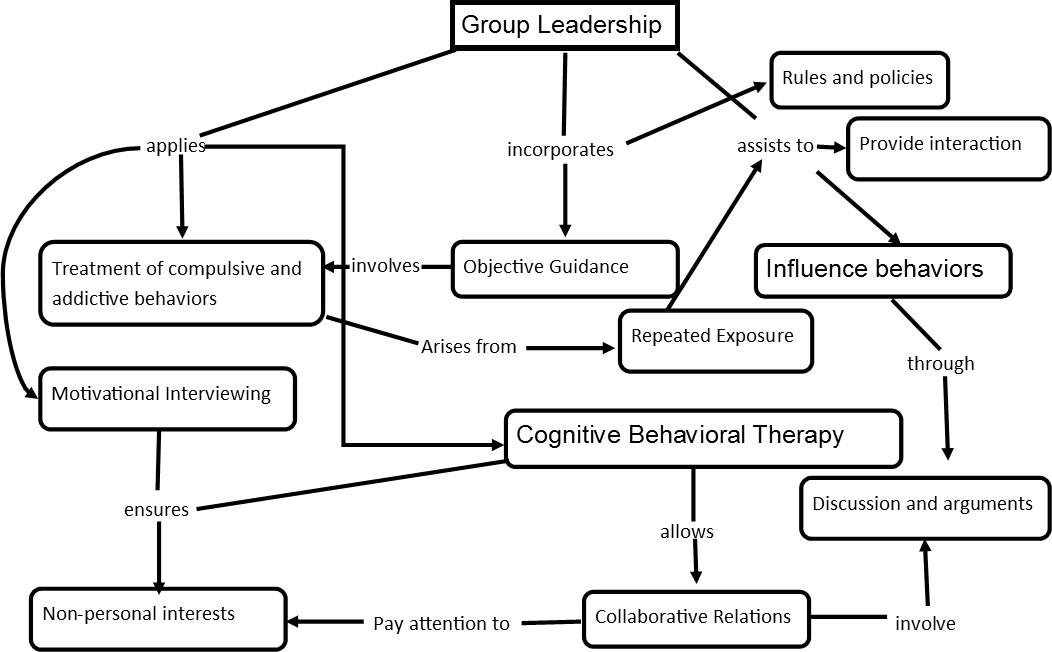Introduction
This personal model aims at creating a conceptual map from an individual perspective. Leadership is a process of social influence in which one person can influence the behavior of others. It is, therefore, apparent that there must be the leader and followers (Clark, 2003).
The leader must be influential and directive to the people. This implies that the leader must understand the followers’ behaviors. There are different leadership techniques that include authoritative, motivational, persuasive and democratic leadership.
In democratic leadership, group members can contribute to the group proceedings. Consequently, group leadership will depend on cognitive behavioral therapy and leadership style to modify behaviors.
Cognitive Behavioral Therapy [CBT]
It is a psychotherapeutic approach that evaluates the cause of failure in a group (Lencioni, 2002). The leader should encourage teamwork and give directions like a counselor. This ensures that the decisions do not incorporate personal interests.
A responsible leader is time observant and does not misuse resources. I would allow the members to participate and make implementations on the group proceedings. Participation could be facilitated by arguments and discussions. This aspect motivates members towards achieving the group’s goals.
CBT acknowledges that some behaviors can be controlled through irrational thoughts only.
Consequently, I would appraise collaborative techniques to bring to enhance free interactions. Since group therapy aims at addressing the group problems, I would select specified strategies to solve subject issues.
These incorporate encouraging teamwork, use of education strategy, and hiring external experts to identify the problem. Their specialty allows them to identify a remedy.
Participation in collaborative relations will enable the groups to handle large problems and find solutions. Therefore, I would evaluate members to identify the remedy of a group’s problem without making a personal judgment.
Additionally, I realized that there are different behaviors in a group. Addictive behavior arises from the environment of interaction. A person may address some subjects or issues and neglect others.
Most of these behaviors are informal, voluntary, generated behaviorally, set by the management or dependent on personal preferences. The other behaviors incorporate rules, values, and policies. Rules refer to mandatory guidelines that I would exercise in the group.
Values are the aspects that I would expect from each group member. Policies state how the group followers should be treated. Therefore, I would be complacent when evaluating whether a problem relates to compulsive or addictive behavior.
Leadership Style
In a group, it is apparent that democratic leadership is quite effective. This is because the members can participate in decision making. This cultivates a culture of responsibility, handwork and members determination.
Responsible members will always strive towards solving the group’s problem (Shivers, 1980). Development becomes evident when the problems are solved. For this development to survive, the followers must be ready to equip it with the requirement.
Consequently, everyone must attain the willingness and readiness to arouse solutions for development. Democratic leadership will be the most appropriate strategy for a group aiming at solving problems.
Conceptual Map (CM)

The relevance of CM to Personal Model
Lencioni (2002) retaliated that group management must have a definite goal. This map narrows down the ideas presented in the previous personal paragraphs. It was identified that compulsive and addictive behaviors arise from ignorance and repeated exposure.
Consequently, the exposure has been directed towards creating interactions and influencing behaviors. In this way, a member cannot make decisions independently. S/He is influenced by the group members. Motivational and collaborative facilitation will discourage personal interests.
Allowing members to participate in discussions and arguments facilitates democratic leadership. Also, this will enhance interactions between members.
Furthermore, evaluation allows the leader to evaluate the members’ behaviors. Finally, the organization of the group will be controlled by the rules and policies that direct members towards proper group behaviors.
References
Clark, C. C. (2003). American Holistic Nurses’ Association guide to common chronic conditions self-care options to complement your doctor’s advice. Hoboken, N.J.: J. Wiley.
Lencioni, P. (2002). The five dysfunctions of a team: a leadership fable. San Francisco: Jossey-Bass.
Shivers, J. S. (1980). Recreational leadership: group dynamics and interpersonal behavior. Princeton, N.J.: Princeton Book Co.